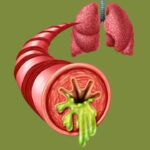Appendicitis is a common digestive disorder, often requiring immediate medical attention to prevent life-threatening complications. Recognizing the symptoms of appendicitis helps patients seek timely medical evaluation, preventing the progression of the condition into a dangerous state.
1. Understanding Appendicitis
The appendix is a short, tube-like structure attached to the cecum (the connecting point between the large and small intestines). While the appendix does not serve a digestive function, recent studies suggest its potential role in the immune system. Appendicitis can occur due to various causes such as blockage by feces, mucus, bacteria, parasites, or tumors. This condition is more prevalent among young adults (16 to 30 years old) and represents a common surgical emergency, accounting for up to 40% of total cases.
Failure to accurately diagnose and promptly treat appendicitis can lead to complications, including a risk of mortality.

Appendicitis is a common digestive disorder
2. Symptoms of Appendicitis to Watch For
Appendicitis progresses rapidly, and individuals experiencing the following signs should promptly seek medical attention to receive a thorough examination and appropriate treatment:
2.1. Right Lower Abdominal Pain
Characteristic appendicitis pain often begins suddenly at any location in the abdomen and localizes to the right lower quadrant over a few hours. The pain may intensify over 24 hours, becoming more severe with movements, coughing, or palpation. The nature of the pain can vary based on factors like inflammation, the appendix’s location, the patient’s immunity, or current medication.
2.2. Fever and Chills
Appendicitis may cause a fever of up to 38°C, indicating the body’s response to infection. Higher fevers between 39°C and 40°C may be a signal of peritonitis by a perforated appendix, accompanied by chills and shivering.
2.3. Gastrointestinal Disturbances
Common symptoms include prolonged vomiting, abdominal bloating, loss of appetite, diarrhea, or constipation. Poor appetite and aversion to food are crucial signs reinforcing the appendicitis diagnosis. Their absence may warrant a reevaluation of the diagnosis.
3. Dangers of Appendicitis
3.1. Perforated Appendicitis Complications
Perforation leads to the release of pus into the abdominal cavity, causing infection, sepsis, and systemic shock. Approximately 15% of patients face complications within 36 hours of the initial symptoms, marking the most perilous stage of appendicitis.
Symptoms include severe abdominal pain, high fever, lower body temperature, low blood pressure, delayed bowel movements, and abdominal distension. Immediate emergency care is essential to prevent life-threatening outcomes.
3.2. Appendiceal Abscess
This occurs when the ruptured appendix is encapsulated by surrounding structures, preventing widespread infection. Although less severe than peritonitis, an appendiceal abscess still poses a risk of rupture and peritonitis if not correctly managed.
Detection often involves ultrasound or abdominal CT scans, and treatment typically includes drainage and antibiotics to address infection. After recovery, the inflamed appendix may be surgically removed.

Peritonitis is the most dangerous complication of apendicitis, occurring when the appendix becomes inflamed and ruptures, flowing into the abdomen.
3.3. Appendiceal Mass
A less common complication involves the formation of an appendiceal mass, where adjacent structures encapsulate the inflamed appendix. While some cases may spontaneously resolve, others progress to appendiceal abscess or necessitate further observation and treatment.
4. Appendicitis Diagnosis
Typically, characteristic appendicitis symptoms are easily identifiable during a physical examination, with patients experiencing abdominal rigidity upon palpation. Additional diagnostic tests, such as blood tests, urine analysis, ultrasound, X-rays, barium enemas, or CT scans, play a crucial role in confirming atypical cases. These tests reduce misdiagnosis rates from 30% to 14%, with CT scans boasting a mere 7% error rate.
5. Treatment of Appendicitis
The standard approach involves surgical removal of the inflamed appendix. Surgeons recommend performing the operation as early as possible to prevent worsening symptoms and complications. Non-surgical options, such as antibiotic treatment, may be considered for cases without complications. However, recurrent appendicitis occurs in up to 30% of successfully treated cases, emphasizing the limited efficacy of non-surgical methods.
In conclusion, the symptoms of appendicitis are often recognizable, enabling successful diagnosis and treatment when patients seek prompt medical attention. However, in atypical cases, accurate diagnosis may pose challenges, underscoring the importance of not dismissing any bodily changes. Suspected symptoms warrant immediate medical evaluation to ensure accurate and timely intervention.








